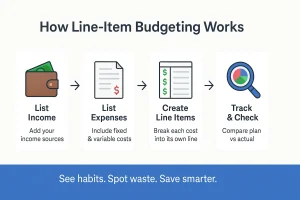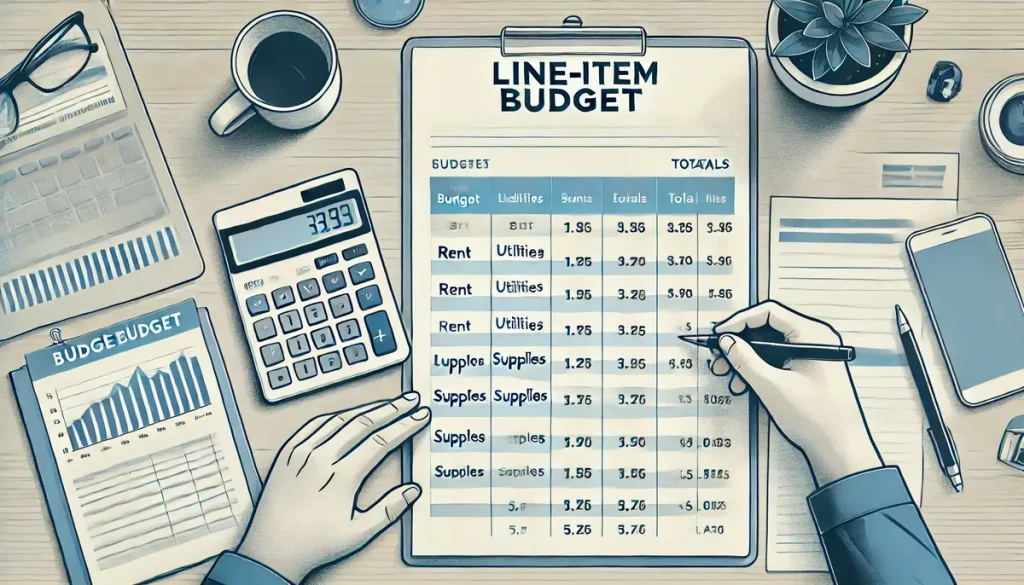When inflation and living costs go up, it is important to have clear finances. Line-item budgeting is a very powerful tool for this. It breaks down your money into a simple list. This helps you handle rising costs. You can also build a debt-free future.
What Is Line-Item Budgeting?
A line item budget is a detailed financial plan. It lists your income. Then, it breaks down expenses into categories. These are called “line items.” You can organize your expenses. You group related costs together on separate lines. This creates a full financial picture.
A line item budget also helps you plan for costs. You can anticipate costs within each category. Then, you can watch your spending closely. This helps you stick to your budget. It also stops you from overspending in any one area.
This method is different from traditional budgeting. Traditional budgeting often groups expenses into big categories. For example, a traditional budget might just have one amount for “operations.” A line-item budget would break that down. It would show specific costs like “salaries,” “rent,” “utilities,” and “travel.” This high level of detail helps control costs. It also ensures people are held accountable.
Many organizations use line-item budgeting. It is very common in the public sector. Many government agencies, cities, and schools use it for transparency and control. Nonprofits also use it to show donors exactly how their money is spent. Even large businesses use it to control spending in each department. It is a great way to track personal finances in detail and prevent overspending.
Key Benefits of Line-Item Budgeting
Line-item budgeting is a great tool to make smarter choices with your money.
1. Track Every Expense in Detail
Every dollar you spend has a place in your budget. You know exactly where your money goes. You won’t have any surprises at the end of the month. This helps you understand your spending habits.
2. Control Your Money Better
This budget makes it easy to find where you overspend. You can quickly see which categories are over budget. This helps you fix problems fast. It gives you more control over your spending and your savings.
3. Be Open and Accountable
For businesses, this budget is good for being transparent. It shows investors exactly how money is used. This builds trust. For families, it helps everyone agree on money goals. It helps you hold each other accountable.
4. Compare Spending Over Time
Since every cost is listed, it’s easy to compare spending year after year. You can see how costs change over time. This helps you guess future costs. It makes it easier to plan for the years ahead.
5. Helps You Pay Off Debt
This budget shows you all your income and expenses. This makes it easy to find where you can save money. You can then use that extra money to pay down debt. It helps you stay focused on your goal.
How Line-Item Budgeting Works
Line-item budgeting may sound hard. But it is simple. It’s like assigning every dollar where it will be spent. Instead of grouping costs together, you list each one by itself. This shows exactly where your money goes.

Here’s how it works:
- Start with your income. Write down how much money you make each month. This can be your salary, side job, or any other income.
- List your expenses. Begin with fixed costs. These are things like rent, insurance, or loan payments. Then add flexible costs like food, gas, or fun spending.
- Create line items. Put each cost in its own spot. For example, instead of just writing “utilities,” write electricity, water, and internet.
- Track and check. Compare your plan with what you really spent. This helps you see waste, like unused subscriptions or too many takeout meals.
You don’t need advanced tools. A simple Excel or Google Sheet is enough. If you want apps, you can use YNAB, Mint, or QuickBooks. These make it easy to update your budget.
The power of line-item budgeting is in the details. You don’t just see numbers. You see habits, find out what matters most, and ways to save.
Pros and Cons of Line-Item Budgeting
Line-item budgeting has both pros and cons. Knowing both can help you decide whether to opt for it or not.
- Pros: The best part is clarity. Every cost is listed. You know exactly where your money goes. This helps you be disciplined. It holds you accountable. It’s hard to overspend when you see the numbers. This is best for businesses and families. It also makes comparing spending easy. You can spot trends and plan for the future.
- Cons: This type of budget can take a lot of time. You must track every small expense. It can also be too rigid. It is hard to move money from one category to another. It might be too detailed for people who like a simpler budget.
Line-Item Budgeting vs Other Budgeting Methods
Line-item budgeting is one way to manage your money. Let’s compare it with other methods to see how it stands out and where it’s not a good choice for you.
Line-Item Budgeting vs. Zero-Based Budgeting
Both methods are very detailed. But their main ideas are different. A line-item budget focuses on putting every expense into a category. It helps you know where your money went. A zero-based budget is more aggressive. It makes you give every dollar of your income a job. Your income minus your expenses should equal zero. It is not just about tracking. It is about giving every dollar a purpose from the start.
Line-Item Budgeting vs. the 50/30/20 Rule
The 50/30/20 Rule is a simpler method. It splits your income after taxes into three big groups. 50% is for needs. 30% is for wants. 20% is for savings and debt. This rule is easy to follow. But it does not offer detailed control. You may know you spent within your “wants” limit. But you will not know exactly what you spent it on without more tracking.
Line-Item Budgeting vs. the Envelope System
The envelope system is a classic, physical method. You put cash into labeled envelopes. Each envelope is for a different spending category. Examples are “Groceries” or “Entertainment.” Once an envelope is empty, you stop spending from that category for the month. Line-item budgeting is a digital version of this. The envelope system is a very real way to see your money. But a line-item budget is more flexible for online payments.
Common Mistakes to Avoid with Line-Item Budgeting
Line-item budgeting is a great tool. But it’s not perfect. Many people face problems when they start. Avoiding these mistakes can save you frustration. It can also help you stick to your budget.
1. Forgetting to Update Expenses Regularly
This is the most common mistake. You make a perfect budget. But then you forget to track your spending. Expenses can add up quickly. Soon, your budget doesn’t match your spending. To avoid this, form a habit. Check your budget daily or weekly. It only takes a few minutes. But it helps a lot.
2. Making Categories Too Broad or Too Detailed
It’s important to find the right balance with your categories. If they are too broad, you won’t have enough detail. You won’t see where you overspend. But if they are too detailed, it becomes a lot of work. So, try to find a middle ground that works for you.
3. Not Planning for Irregular Expenses
Your budget is not just for monthly bills. Many people forget to plan for costs that happen less often like yearly insurance payments, car registration fees or birthday gifts. When these costs appear, they can ruin your monthly budget. A good tip is to create a separate “irregular expenses” line item. Save a little money in it each month. This way, you will be ready for those costs.
Why Line-Item Budgeting Matters in 2025
In 2025, everything seems to cost more. Living costs are rising. Inflation is a real challenge. For many people, debt is a constant worry. It is easy to feel like you are losing control of your money. Simply “spending less” is not a good enough plan. This is why line-item budgeting is more important than ever.
This method gives you a clear view of your money. It is a powerful solution for financial challenges. It breaks down every expense into a separate line. You can quickly find out where your money is going. You can then make smart choices to control your spending. In a world where every dollar counts, a line-item budget gives you the clarity you need. It helps you handle rising costs. It also helps you work toward a debt-free future.
FAQs About Line-Item Budgeting
1: What is line-item budgeting?
Line-item budgeting is a detailed money plan. It lists your income and breaks every expense into its own category, called a line item. This gives you a clear picture of where every dollar goes.
2: What is the difference between line-item budgeting and performance budgeting?
Line-item budgeting tracks spending by categories like rent, salaries, or utilities. Performance budgeting, on the other hand, links money to results or outcomes. One focuses on “what you spend,” while the other focuses on “what you achieve.”
3: What is line-item budgeting in public administration?
In public administration, line-item budgeting is used by governments, schools, and nonprofits. It ensures transparency by showing exactly how public money is spent. This builds trust and makes it easier to control costs.
4: Is line-item budgeting better than zero-based budgeting?
Line-item budgeting gives you detailed tracking of expenses. Zero-based budgeting makes you assign every dollar to a purpose. Line-item is about knowing where money goes, while zero-based is about controlling where money goes from the start.
5: Can beginners use line-item budgeting?
Yes, beginners can use it. Start simple with just a few categories. Over time, you can add more detail as you get used to tracking.


